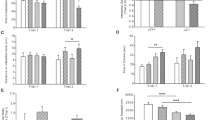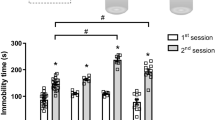Abstract
Neuroactive steroidal modulation of immobilization-stress and possible involvement of GABA-A and mitochondrial diazepam binding inhibitor (DBI) receptors (MDR) has been investigated in mice. Immobilization of mice for 2 h induced intense antinociception, anxiety state, and associated with a fall in adrenal ascorbic acid levels. Pretreatment with high dose of progesterone (10 mg/kg), a precursor of neurosteroids, significantly decreased the stress-induced antinociception, anxiety and fall in adrenal ascorbic acid, while low doses (1 and 5 mg/kg) or hydrocortisone (10 and 100 mg/kg) were ineffective. In contrast, progesterone (1 mg/kg, for 9 days) produced a significant antistress effect, which was blocked by GABA-A antagonists picrotoxin (1 mg/kg) and bicuculline (1 mg/kg), but not by flumazenil (2 mg/kg), a specific benzodiazepine (BZD) antagonist. 4′-chlordiazepam (0.1 and 0.25 mg/kg), a specific high affinity MDR agonist, produced significant anti-stress effect in a flumazenil-insensitive manner, but was blocked by pretreatment with PK11195 (1.5 mg/kg), a selective partial agonist of MDR, and with bicuculline (1 mg/kg), a potent GABA-A receptor antagonist. At higher doses, progesterone and 4′-chlordiazepam which are effective in immobilization stress also reduced locomotion. However, lower doses of progesterone (6.5 mg/kg) neither affected locomotion, nor produced any motor toxicity on rota-rod test. At the lower doses, the MDR ligand 4′-chlordiazepam (50 μg/kg) decreased locomotor activity, without altering motor toxicity on rota-rod test. Further, the per se effects of these treatments on unstressed mice were not significantly different from those of untreated controls, except for plus-maze test. The antistress profile of progesterone may be attributed to the in vivo production of neurosteroid allopregnanolone, thus resembled that of BZDs. Furthermore, the antistress actions are flumazenil-resistant, reaffirming that there may be an increase in the levels of pregnane neurosteroids in vivo, which may act on a specific allosteric site on GABA-A receptors distinct from BZD site. Because 4′-chlordiazepam binds to MDRs and stimulate mitochondrial neurosteroidogenesis, the anti-stress effects of 4′-chlordiazepam may be imputed to its MDR-induced neurosteroids, which then act on GABA-A receptors. These data suggest a pivotal role for GABA-A and mitochondrial DBI receptors in the antistress actions of neurosteroids and reinforces their ameliorative effect in physiological stress.
Similar content being viewed by others
Author information
Authors and Affiliations
Additional information
Received: 20 February 1996/Final version: 26 June 1996
Rights and permissions
About this article
Cite this article
Reddy, D., Kulkarni, S. Role of GABA-A and mitochondrial diazepam binding inhibitor receptors in the anti-stress activity of neurosteroids in mice. Psychopharmacology 128, 280–292 (1996). https://doi.org/10.1007/s002130050136
Issue Date:
DOI: https://doi.org/10.1007/s002130050136




